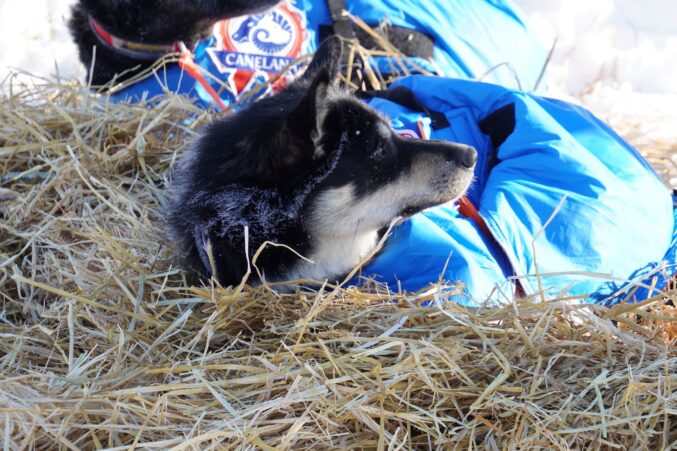All eyes have been glued on the tracker today as the Iditarod starts to set up in anticipation the top five finishers’ order. Checkpoint denizens will mentally calculate the time it will take for the musher to arrive, based on GPS data from the unit each musher carries. The trail down to Unalakleet is long, relatively straight and quite cold. The wind picks up, and the mushers have to break the run into sections. Some opt to stay at the cabin at Tripod Lake, while others choose to rest up for a while at the famous Old Woman Cabin. The trail goes southwest until reaching the Bering Sea Coast. Then the trail cuts north and slightly east, following the coast to Shaktoolik and Koyuk, then back west to Nome. Throughout this section of the trail, winds blow and temperatures plummet.
At every checkpoint I’ve been to, the anticipation builds as a musher nears the checkpoint. The GPS tracker is on a laptop or screen in each checkpoint so that volunteers, officials, and community members can see it. The kids here in Unalakleet are just as excited as the adults. One way that’s a little different here than from other checkpoints is that shortly before a musher is due to arrive, a stack of pizzas arrives from Peace on Earth addressed to the musher from somewhere around the country, even the world.

Pizza ordered from fans around the country stacked up at the checkpoint. Photo: K. Newmyer
Calculating the arrival times into a checkpoint is a great way to engage your students in a math lesson. For example, right now, the GPS tracker says Dallas Seavey, the frontrunner, is racing at 7.7 miles per hour at race mile 764. How long will it take him to reach Koyuk, the next checkpoint, at mile 804? This is a multi-step problem, so students need to decide how to use the information they have to figure out what they don’t know. How many miles is the distance Dallas needs to cover before reaching Koyuk? 804 – 764 = 40. How long will it take him to go 40 miles at 7.7 miles per hour? The formula for that is Speed = Distance divided by Time, or S = D/T. But we already know the speed, so we have to refigure the formula to get Time = Distance divided by Speed. So if we need to know how long it will take Dallas to get to Koyuk, we can divide the distance, 40 miles, by the speed he’s going, 7.7 miles per hour, and get about 5.19 hours. But is it really 5 hours and 19 minutes? Not exactly. I rounded up to .20 and remembered that that’s 1/5 of an hour, so 60 divided by 5 is 12. It will take Dallas 5 hours and twelve minutes, that is, if his speed doesn’t change.

Dallas Seavey is the first team to arrive to the halfway point of the Iditarod’s Northern route, Cripple, the evening of March 6th, 2024. Photo: Siri Raitto
If you didn’t follow my math, don’t worry, I have an odd way of doing mental calculations because I think in pictures. If you are teaching any of the concepts mentioned above—multi-step problems, the formula for speed, time and distance, even basic ideas like multiplication or division—you can use these race stats to boost engagement in your math lessons and make it way more fun. For example, if two mushers have the same number of miles to go before a checkpoint, and one is going slightly faster, how much sooner will they reach the checkpoint? You can use race stats to come up with all sorts of problems for students to solve.
As soon as the musher and his or her dog team gets within 2 miles or so of the checkpoint, everyone wants to welcome the team into the checkpoint so they start putting on their neck warmers, hats, jackets, and gloves over bibs, snowpants, and down jackets. It’s cold! The weather from Weather Underground reports that Unalakleet’s temperature right now is -15 degrees Fahrenheit, but it feels like -29 degrees. What does that mean? Wind chill is something that we’ve all heard about: wind will make the temperature feel colder. The National Weather Service formula for calculating wind chill is quite complicated and is based on the effects of air temperature and wind speed on human skin. The formula is not as user friendly as the distance/speed/time one as you can see at the bottom of the chart.

Wind Chill Chart from the National Weather Service.
You can have students look at the chart and notice patterns. It works like a times table, where you move across the top for the air temperature, down the left side for the wind speed, then meet in the middle. What do the frostbite times mean? Why is knowing about wind chill so important? What precautions will trail crew workers have to take? How does that affect the pizza being delivered? What will that mean for veterinarians who are outside checking on dog teams? And for that matter, what about the dogs?
Luckily, the dogs are perfectly happy in the cold weather. Here are some photos of the amazing athletes as they get fed, watered, booties pulled off, and their cozy straw to sleep on. As you marvel at the amazing ability of the dogs to close the miles between checkpoints and stay warm in the cold, remember how fun it is to learn math when you’re in the middle of the Iditarod.

A Travis Beals dog resting at Unalakleet. Photo: K. Newmyer

Two of Matt Hall’s dogs resting. Photo: K. Newmyer

A dog of Ryan Redington’s rests in Unalakleet. Photo: K. Newmyer
Email me with your mathematical insights at emailtheteacher@iditarod.com.


